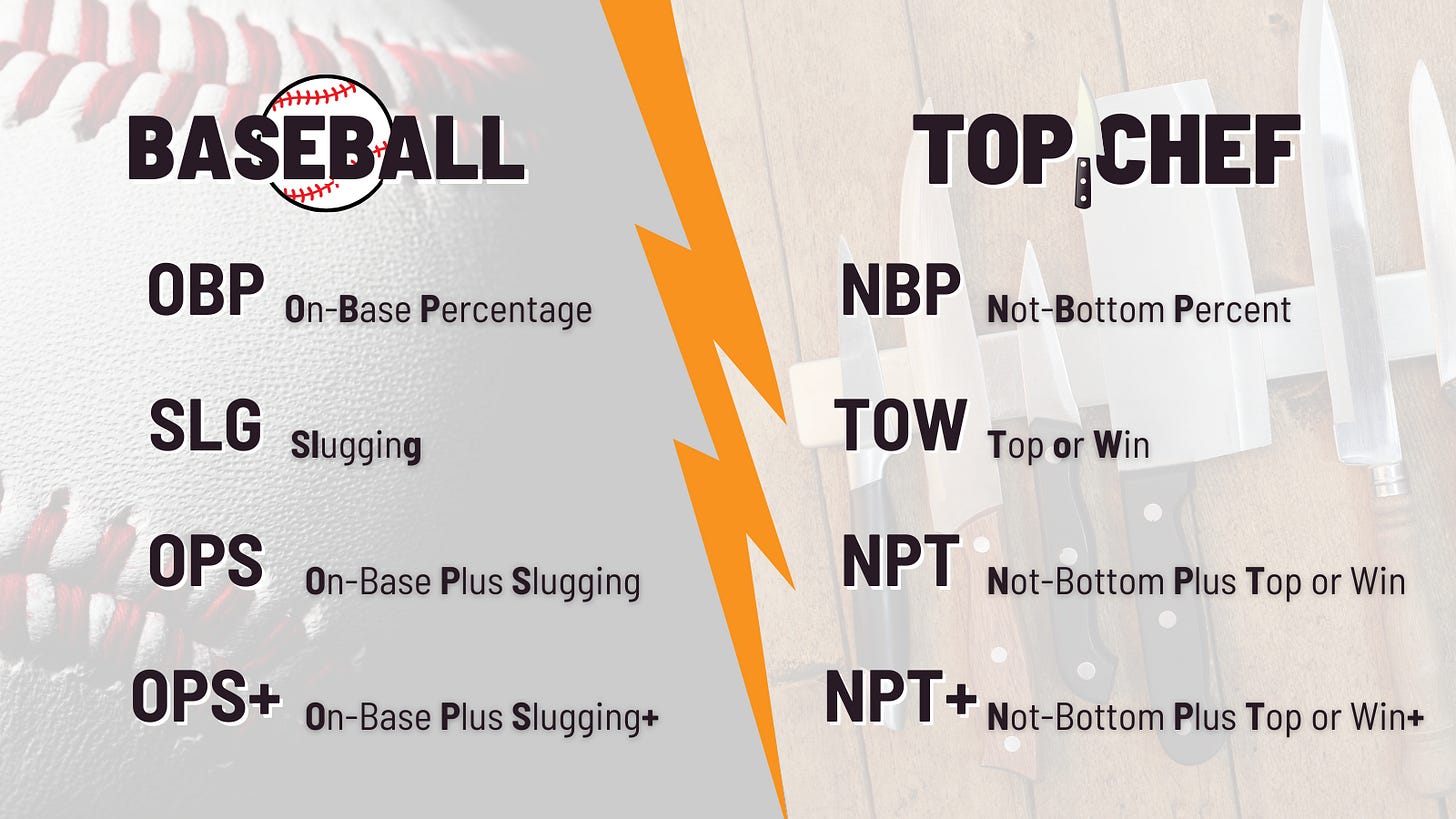Does a new Top Chef statistic change who the GOATs are?
I’m not much of a sports person, but I have so much respect for sports statistics. Now, I can’t take credit for this new Top Chef statistic I’m introducing - all credit goes to my partner. His love of baseball inspired this, and then we talked about what the Top Chef equivalent would be.
Quick sidebar about some baseline statistics: On-base percentage (OBP) is how frequently a batter reaches a base per plate appearance. Slugging percentage (SLG) is the total number of bases a player records per at-bat. OPS combines these two metrics: On-base percentage Plus Slugging percentage. Then, OPS+ takes OPS and normalizes it across the whole league.
By modifying these statistics for Top Chef, it fixes the current problem I have with comparing seasons using my methodology. My methodology requires the same number of Quickfire and Elimination challenges, and so I can only say things such as: “Up to and through 12 Quickfire challenges and 10 Elimination challenges, so-and-so had the best score.” The metric assumes that everyone competed in that number of challenges, when that is not the case (e.g., people who were eliminated prior to 10 elimination challenges would have less opportunity to contribute data).
What this new statistic will do for Top Chef is that it will not only account for the percentage of time chefs win, but also for how frequently they continue on in the competition. With the exception of the final elimination challenge, it’s actually okay for chefs to not win a challenge - they just need to not lose. This is something that many of you already take into account in your fantasy leagues. This new statistic will allow us to now compare that across seasons.
So! Let’s get into it.
What challenges are included: Elimination, Quickfire, Sudden Death Quickfire, and Quickfire Elimination. I decided to exclude qualifying challenges because it sort of feels like Spring Training in baseball: it’s definitely a game/challenge, but it doesn’t count towards season statistics.
NBP (Not bottom percentage) is the Top Chef equivalent of OBP. Just because a baseball player got on base doesn’t mean they got a homerun, but it does mean they’re moving forward. So this will be the number of times a chef was NOT in the bottom of a challenge or eliminated divided by the number of challenges.
TOW (Top or win percentage) is the Top Chef equivalent of Slugging. It’s how far they got per at-bat. This will be the number of times that they were at the top of or won a challenge divided by the number of challenges.
NPT (Not bottom Plus Top or win) is the Top Chef equivalent of OPS. It adds up NBP and TOW, combining how well they can move forward in the Top Chef season with their ability to do well.
NPT+ (Not bottom Plus Top or win Plus) is the Top Chef equivalent of OPS+. It takes into account the “league” average (where all of Top Chef US is the league) of each of NBP and TOW. An NPT+ score of 100 is the league average; a score of 150 is 50% better than league average. A difference between NPT+ and OPS+ is that OPS+ is the league’s average for a specific year. However, because there are hundreds of players in an MLB year, and only 12-18 in a Top Chef season (year), I decided to have the Top Chef league average be across all seasons in order to reduce statistical noise. (Note that people’s NPT+ will change slightly as new seasons are aired.)
NPT+ = [(NBP/league average NBP) + (TOW/league average TOW) - 1] * 100
“Uh, what? Carly, I like Top Chef, not math,” you might be saying to me right now. An example to make this more concrete is comparing two chefs from Season 22: Tristen Epps and Bailey Sullivan. Tristen rates super high in NPT+ with 289 because he almost never stumbled into the bottom 3 and routinely played himself into the top like ice cubes in a cocktail glass - he has a high NBP and high TOW, compared to the average Top Chef contestant. His NPT+ is interpreted as him being 189% better than the average chef on Top Chef. Compare that to his fellow finalist, Bailey, whose NPT+ is 28. She was in the bottom much more frequently than average (a low NBP) and in the top less frequently (a low TOW). You can interpret her NPT+ as being 72% worse than the average chef on the show (but she was a finalist, so I’m definitely not knocking her skills as a chef).
Now let’s compare with my previous GOAT list. These four chefs met three of the four criteria I laid out in that list (in chronological order of when the season aired): Stefan Richter (Season 5), Brooke Williamson (Season 10), Gregory Gourdet (Season 12), Buddha Lo (Season 20).




